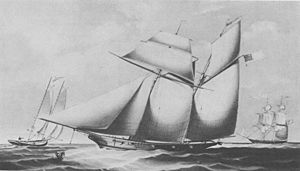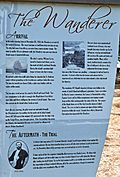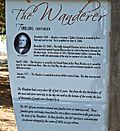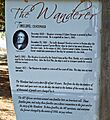Wanderer (slave ship) facts for kids
class="infobox " style="float: right; clear: right; width: 315px; border-spacing: 2px; text-align: left; font-size: 90%;"
| colspan="2" style="text-align: center; font-size: 90%; line-height: 1.5em;" | 
|} Wanderer was a ship that illegally brought a large group of people from Africa to the United States. This happened on November 28, 1858, when the ship landed at Jekyll Island, Georgia. It was one of the last ships to carry a big cargo of about 400 people for the illegal slave trade. Another ship, the Clotilda, brought 110 people in 1860 and is known as the very last ship to bring enslaved people from Africa to the U.S.
Wanderer was first built in New York as a fancy pleasure boat called a schooner. Later, a businessman from the South named Charles Augustus Lafayette Lamar and his friends bought it. They planned to use it to illegally bring kidnapped people from Africa. The Atlantic slave trade had been against U.S. law since 1808.
About 409 enslaved people survived the long journey from the Kingdom of Kongo (in Africa) to Georgia. When news of this illegal act spread, many people in the North were very angry. The U.S. government tried to take legal action against Lamar and others involved in 1860, but they were not found guilty.
During the American Civil War, the U.S. Navy took control of the ship. They used it for different military jobs. After the war ended in 1865, the ship was sold and used for regular trade. Sadly, it was lost off the coast of Cuba in 1871.
In November 2008, the Jekyll Island Museum opened a special display about the enslaved Africans who arrived on Wanderer. A memorial statue was also put up on Jekyll Island to remember these people.
Contents
| History | |
|---|---|
| Name | Wanderer |
| Launched | 1858 |
| Fate | Lost 12 January 1871 |
| Notes |
|
| General characteristics | |
| Displacement | 300 tons |
| Length | 106 ft 0 in (32.31 m) |
| Beam | 25 ft 6 in (7.77 m) |
| Draught | 9 ft 6 in (2.90 m) |
| Propulsion | Sails |
| Sail plan | Schooner-rigged |
| Speed | 20 knots (37 km/h; 23 mph) |
- Building Wanderer
- Wanderer Arrives at Jekyll Island
- Government Response
- The Wanderer Survivors
- Wanderer After the Illegal Voyage
- Remembering Wanderer
- Images for kids
The Illegal Slave Trade
The buying and selling of people across the Atlantic Ocean, known as the Atlantic slave trade, was made illegal by both Britain and the United States in 1807 and 1808. Britain's navy, the Royal Navy, started stopping illegal slave ships off Africa in 1807. The U.S. did not do much to stop the trade until 1820. Even then, U.S. ships often did not allow British ships to search vessels flying the American flag. This made it easier for illegal slave traders to avoid being caught.
Even after the U.S. made the slave trade illegal, some people continued to bring enslaved people from Africa. In the late 1850s, some people in the Southern states wanted to restart the slave trade.
Wanderer Prepares for its Journey
Wanderer was built in 1857. In 1858, it was partly set up for a long trip. Many people wondered what the ship would be used for. It was checked in New York harbor, but since there was no clear proof it would be used as a slave ship, it was allowed to leave. It sailed away flying the flag of the New York Yacht Club and was led by Captain Corrie.
When Wanderer stopped in Charleston, South Carolina, on its way to Africa, its secret mission was so well known that people greeted it with a cannon salute.
The Voyage and Arrival
Captain Corrie sailed to the mouth of the Congo River in the Kingdom of Kongo (now part of the Democratic Republic of the Congo). This area was a Portuguese territory and had a long history of slave markets. For 10 days, workers built shelves and pens in the ship's lower deck to hold people. About 490 to 600 people were forced onto the ship. Many of them died during the six-week journey across the Atlantic Ocean.
Wanderer arrived at Jekyll Island, Georgia, on November 28, 1858. It delivered 409 enslaved people who had survived the terrible voyage.
Legal Actions and Impact
After the ship arrived, legal actions were started against the slave traders. However, the people involved were found not guilty by a jury in Georgia. Many believe that the anger caused by this case helped increase tensions between the North and South, leading to the American Civil War.
Some of the people involved in the Wanderer case later fought on opposite sides in the Civil War. For example, John Egbert Farnum became a high-ranking officer for the Union Army, while Charles Augustus Lafayette Lamar became a major general for the Confederate Army. Lamar was the last officer to be killed in the Civil War.
During the war, Union troops took control of the ship. They used it to help block the ports of the Confederate States of America.
Building Wanderer
Wanderer was built in a shipyard in Setauket, New York in 1857. It was designed as a fast, fancy yacht for a man named Colonel John Johnson. The ship's sleek shape allowed it to travel very quickly, up to 20 knots (37 km/h; 23 mph), making it one of the fastest ships of its time.
While on a trip, Johnson sold Wanderer to William C. Corrie in Charleston, South Carolina. Corrie then partnered with a rich businessman named Charles Augustus Lafayette Lamar from Savannah, Georgia. Lamar hired Corrie to bring enslaved people from Africa, even though it had been against federal law since 1808. Both men were against the laws that stopped the import of enslaved people, because the demand for them made their prices very high.
Wanderer was taken back to New York to get ready for a long journey. Some people thought the shipyard was preparing it to be a slave ship. The ship was inspected and allowed to leave, but rumors about its use in the slave trade continued.
Wanderer Arrives at Jekyll Island
In his ship's log, Captain Corrie wrote that he arrived at Bengula (likely Benguela in present-day Angola) on October 4, 1858. Wanderer took on 487 enslaved people between the Congo and Benguela. After a six-week trip across the Atlantic, Wanderer reached Jekyll Island, Georgia, on November 28, 1858. Records showed that 409 enslaved people survived the journey. They were brought ashore at Jekyll Island, which was owned by John and Henry DuBignon, Jr., who were working with Lamar.
Hoping to avoid being caught, Lamar had the enslaved people sent to markets in Savannah and Augusta, Georgia, as well as in South Carolina and Florida.
As the government investigated, news of the slave ship made people in the North very angry. People in the South pushed Congress to reopen the Atlantic slave trade. The government tried Lamar and his partners three times for piracy, but they could not get a conviction. The jury was not convinced that Lamar was directly connected to the ship's illegal actions.
Government Response
The arrival of Wanderer made the government under President James Buchanan take stronger action against the slave trade. After the 400 Africans were spread out and sold across the South, there were rumors that more slave ships had landed. The Buchanan Administration sent a "secret agent" named Benjamin F. Slocum to look for proof.
Slocum worked secretly, talking to traders, plantation owners, and townspeople. He followed every possible clue. In the end, he wrote a detailed report. He concluded that the rumors of other landings were either about the Wanderer group or were just made-up stories for political reasons or to sell newspapers.
Based on this investigation, President Buchanan told Congress on December 3, 1860, that "not a single slave has been imported into the United States in violation of the laws prohibiting the African slave trade" since his last report.
The Wanderer Survivors
The enslaved people who arrived in the U.S. on Wanderer became well-known. Newspapers in New York, Washington, and London wrote about their story. They were one of the few groups of enslaved people who were often identified by the ship they arrived on. This suggests that there were no other known large-scale illegal imports of African enslaved people around that time.
However, the Clotilda arrived in July 1860 in Mobile Bay, Alabama, with about 110 surviving enslaved people. The ship was sunk to hide the illegal act. In 2018, it was reported that the remains of a ship that might be the Clotilda were found. It is now known as the last ship to have carried enslaved people to the U.S. before the Civil War.
Wanderer After the Illegal Voyage
Over the next two years, Wanderer was owned by different people. In November 1859, the ship sailed again on another illegal slave trip. A crew of 27 "stole" the ship from its owner, seemingly with help from port officials. Some reports say it sailed in daylight, others say it left very early in the morning. The owner, who was suspected of being involved, tried to chase it on another ship.
Near the coast of Africa, the first mate led a rebellion and left the captain at sea in a small boat. The mate said he had been forced onto the ship. He sailed Wanderer to Fire Island, then to Boston, Massachusetts. When he arrived in Boston on December 24, 1859, the mate gave the ship to federal authorities. Ten men were put in prison, and those who had been forced onto the ship were set free.
In April 1861, when the American Civil War began, the United States Government took Wanderer. They wanted to stop it from falling into the hands of the Confederate States of America. The ship served in the United States Navy from then until June 1865. It was used as a gunboat, a supply ship (called a tender), and a hospital ship. After being sold for regular trade in June 1865, Wanderer was used commercially until January 12, 1871, when it was lost off Cape Maisí, Cuba.
Remembering Wanderer
For a long time, most historians believed that Wanderer was the very last slave ship to reach the U.S. This was even written by W. E. B. Du Bois in his book about the end of the African slave trade. However, the schooner Clotilda landed enslaved people in 1860 and is now known as the last slave ship to bring captives to the U.S.
In 2008, the state of Georgia put up a monument to the African survivors of Wanderer on the southern tip of Jekyll Island. The monument has three 12-foot (3.7 m) steel sails and several signs that tell the story. On November 25, 2008, a special event was held to dedicate the memorial. About 500 people attended, including descendants of the enslaved people carried by Wanderer. Erik Calonius, who wrote a book called The Wanderer: The Last American Slave Ship and the Conspiracy that Set Its Sails (2008), was also there. He is given credit for helping to bring the story of Wanderer back into public interest.
Images for kids





